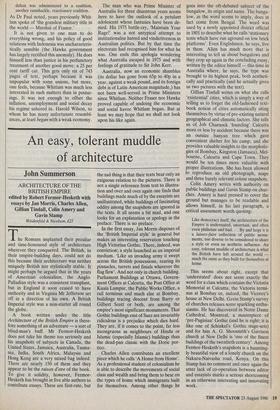An easy, tolerant muddle of architecture
John Summerson
ARCHITECTURE OF THE BRITISH EMPIRE edited by Robert Fermor-Hesketh with essays by Jan Morris, Charles Allen, Gillian Tindall, Colin Amery and Gavin Stamp
Weidenfeld & Nicolson, f25
The Romans implanted their peculiar and time-honoured style of architecture wherever they conquered. The British, in their empire-building days, could not do this because their architecture was neither uniquely British nor stylistically stable. It might perhaps be argued that in the years of American colonialism, the Anglo- Palladian style was a consistent transplant, but in England it soon ceased to have authority and in Virginia Mr Jefferson set off in a direction of his own. A British Imperial style was a non-starter all round the globe.
A book written under the title Architecture of the British Empire is there- fore something of an adventure — a sort of blind-man's buff. Mr Fermor-Hesketh does not take his theme too seriously and his snapshots of subjects in Canada, the United States, Jamaica, Australia, Tasma- nia, India, South Africa, Malaysia and Hong Kong are a very mixed bag indeed. There are nearly 150 of them and they appear to be the raison d'etre of the book. To give it solidity, however, Fermor- Hesketh has brought in five able authors to contribute essays. These are first-rate, but the sad thing is that their texts bear only an exiguous relation to the pictures. There is not a single reference from text to illustra- tion and over and over again one finds that buildings made much of by the essayists are unillustrated, while buildings of fascinating oddity among the snapshots are ignored in the texts. It all seems a bit mad, and one looks for an explanation or apology in the preface. There is no preface.
In the first essay, Jan Morris disposes of the 'British Imperial style' in general but makes an interesting reservation touching High Victorian Gothic. There, indeed, was conviction; a style launched as an imperial medium. 'Like an invading army it swept across the British possessions, rearing its pinnacles, turrets and finials wherever the flag flew'. And not only in church building. Parliament Buildings at Ottawa, Govern- ment Offices at Calcutta, the Post Office at Kuala Lumpur, the Public Works Office, a rail terminus and much else at Bombay, buildings tracing descent from Barry or Gilbert Scott or both, are among the empire's most significant monuments. That Gothic buildings east of Suez are invariably ridiculous is a prejudice which dies hard. They are, if it comes to the point, far less incongruous as neighbours of Hindu or Islamic (especially Islamic) buildings than the dead-pan classic with the Doric por- tico.
Charles Allen contributes an excellent piece which he calls 'A Home from Home'. As a professional student of colonialism he is able to describe the movements of social class and wealth and bring them to bear on the types of home which immigrants built for themselves. Among other things he goes into the oft-debated subject of the bungalow, its origin and name. The bunga- low, as the word seems to imply, does in fact come from Bengal. The word was used by a newly appointed district official in 1801 to describe what he calls 'stationary tents which have run aground on low brick platforms'. Even Englishmen, he says, live in them. Allen has much more that is interesting to tell us about bungalows and they crop up again in the concluding essay, written by the editor himself — this time in Australia where, he says, the type was brought to its highest peak, both aestheti- cally and practically (and he actually gives us two pictures with the text).
Gillian Tindall writes on what she calls `existential' cities, which is simply a way of telling us to forget the old-fashioned text- book notion of cities automatically siting themselves by virtue of pre-existing natural geographical and climatic factors. She tells us of Job Charnock 'founding' Calcutta more or less by accident because there was an outsize banyan tree which gave convenient shelter for his camp; and she provides valuable insights to the morpholo- gies of Bombay, Kingston (Jamaica), Mel- bourne, Calcutta and Cape Town. They would be ten times more valuable with proper illustrations. She has been allowed to reproduce an old photograph, maps and three barely relevant colour snapshots.
Colin Amery writes with authority on public buildings and Gavin Stamp on chur- ches. Amery is hard pressed to cover the ground but manages to be readable and allows himself, in his last paragraph, a critical assessment worth quoting:
Like democracy itself, the architecture of the Empire is understated, uncertain, and often even philistine and bad. . . By and large it is a laissez-faire collection of public monu- ments, too diverse to be considered to share a style or even an aesthetic influence. An easy, tolerant muddle of architecture is what the British have left around the world much the same as they built for themselves at home.
This seems about right, except that `understated' does not seem exactly the word for a class which contains the Victoria Memorial at Calcutta, the Victoria termi- nus at Bombay or, indeed, the Viceroy's house at New Delhi. Gavin Stamp's survey of churches releases some sparkling enthu- siasms. He has discovered in Notre Dame Cathedral, Montreal, a masterpiece of `pre-Puginian' Gothic (and he is right; it is like one of Schinkel's Gothic stage-sets) and for him A. G. Shoosmith's Garrison church at New Delhi is 'one of the finest buildings of the twentieth century'. Among Fermor-Hesketh's snapshots is a haunting- ly beautiful view of a lonely church on the Nakuru-Naivasha road, Kenya. On this Stamp has no comment and once again the utter lack of co-operation between editor and essayists marks a serious shortcoming in an otherwise interesting and innovating work.










































 Previous page
Previous page